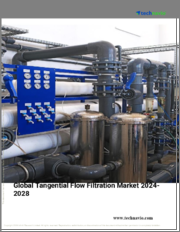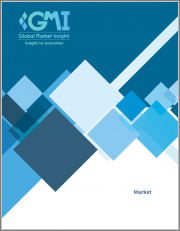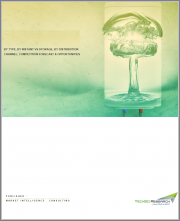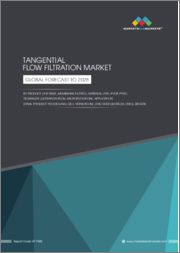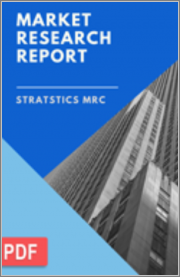
|
시장보고서
상품코드
1273578
세계의 접선유동여과 시장 예측(-2028년)Tangential Flow Filtration Market Forecasts to 2028 - Global Analysis By Product, Membrane Material (Nylon and Polyvinylidene Difluoride and Other Materials), Technique, Application, End User and By Geography |
||||||
Stratistics MRC에 따르면 세계의 접선유동여과(Tangential Flow Filtration) 시장은 2022년 15억 달러를 차지했습니다.2028년 35억 달러에 이를 것으로 예측되며, 15.2%의 CAGR 규모로 성장할 전망입니다.
접선유동여과(TFF)는 생체분자 정제 및 분리를 위한 효과적인 접근법입니다. 접선 유동 여과는 교차 유동 여과로도 알려져 있으며 세포 채취 상류 공정과 바이오 제조에 사용되는 하류 공정 모두 유용합니다. 10 ml 수천 리터 샘플 용액을 농축하고 탈염시킬 수 있습니다. 수확한 세포 현탁액, 미세한 생체분자, 발효 브로쓰, 세포용해액 등을 대량으로 분획함으로써 얻을 수 있습니다.
미국에 본사를 둔 독립적인 학술적 비영리 연구 센터인 Tufts Center for the Study of Drug Development 2021년 보고서에 따르면, 상장하고 있는 최대 바이오 기술 기업 세계의 연구 개발비는 2001년 48억 달러에 이를 전망이며, 2020년 550억 달러 규모에 달하여 매년 13.7%가 증가할 전망입니다.
시장 역학
촉진 요인
접선유동여과 이용률 증가
대표적인 접선유동여과 공정은 역삼투막과 나노여과를 포함합니다. 농축 및 투석 여과 기술은 접선 유동 여과를 사용합니다. 용질 분자를 유지한 채로 액체를 제거함으로써 용액 농도를 높입니다. 투석 여과는 작은 입자와 거대한 입자가 분리되고 나머지 염을별 완충액으로 씻어 내면 마지막으로 총 농도를 변경하지 않고 작은 입자를 남깁니다. 이 방법은 남은 염을 물로 씻어서 용액 농도를 낮추는 데에도 사용할 수 있습니다. 이와 같이, 접선유동여과 이용이 증가하고 있는 것이 예측 기간 중 접선유동여과 시장 성장을 뒷받침하고 있습니다.
억제 요인
고액 자본 지출 필요
제조 설비 건설과 신설에는 많은 설비 투자가 필요하며, 소규모 사업자는 옵션으로 대응하기 어려울 수 있습니다. 또한 원심분리, 다이렉트 플로우 여과, 프리코트 여과 등 첨단 기술 존재는 세계의 접선유동여과 시장 확대를 방해할 것으로 예상됩니다. 또한 많은 제약 회사는 해외 기술, 경험 및 능력을 효과적으로 활용하기 위해 항상 제조 아웃소싱을 수행합니다. 그 결과 완제품 가격이 상승하고 시장 확대가 저해될 수 있습니다.
기회
재조합 단백질 치료 용도, 증가
접선유동여과(TFF)는 생체분자 분리, 정제에 즉효성이 있는 효과적인 기술입니다. 면역학, 단백질화학, 분자생물학(DNA/RNA/올리고뉴클레오티드), 생화학, 미생물학 등 많은 과학 영역에서 유용합니다. TFF는 수년간 단백질과 펩티드 농축, 탈염, 세포 배양액으로부터 항체나 재조합 단백질 회수, 정제, 희박한 단백질 혼합물 분획에 사용되어 왔습니다. 또, 치료법이 집중치료로 이행하는 가운데, 유전자 재조합 단백질 치료에 응용은 큰 확산을 보이고 있습니다. 바이오의약품업계는 재조합 단백질을 상품화하는 경향이 있으며, 접선유동여과 시장 성장을 촉진할 것으로 예측됩니다.
위협
시장 경쟁력 저하와 엄격한 규칙 존재
의약품 사업 정부 엄격한 법규 보급은 세계의 접선유동여과 시장에 도전을 제공할 것으로 예상됩니다. 게다가 시장에는 전통적인 유통 경쟁사가 존재하기 때문에 신규 진입 기업이 제품 오퍼나 신규 기술을 홍보하기 어려워지고 있습니다. 게다가 시장 중요 경쟁사는 다양한 종류 여과 제품을 제공하고 고객으로부터 높은 수준 브랜드 로열티를 얻고 있기 때문에 신규 진입 기업이 이 업계 발판을 구축하는 것은 더욱 어려워지고 있습니다.
COVID-19 영향:
COVID-19 판데믹은 세계의 경제적, 사회적 비용을 증가시키고, 각국 정부는 백신 개발 및 제조 강화를 촉구했습니다. 접선유동여과 제품은 COVID-19 연구에 점점 더 많이 사용됩니다. 백신 개발을 위한 여과 및 정제와 같은 다운스트림 공정을 지원하기 위해 다양한 여과 기술 및 재료가 사용됩니다. 또한 일부 바이오 의약품 회사는 백신 개발을 개선하고 유행을 봉쇄하기 위해 몇 가지 전략을 도입했습니다. COVID-19 유행은 필터 제조사가 제조 설비를 확장할 수 있는 기회도 낳고 있습니다. 이러한 필터 제품은 백신 및 기타 의약품 제조에 사용되기 때문에 백신 대량 생산은 접선 유동 여과 제품 수요에 긍정적인 영향을 미칩니다.
멤브레인 필터 부문이 최대가 될 전망입니다.
멤브레인 필터는 제약 산업을 중심으로 많은 산업 필터 시스템이 사용되기 때문에 유리한 성장을 이룰 것으로 추정됩니다. 이 분야 확대는 PCTE, PVDF, PTFE, PES 등 다양한 종류 필터에 쉽게 접근할 수 있기 때문입니다. 또한 관련 공정 다양한 막 여과 면적과 기공 크기를 이용할 수 있는 점도 이 분야 확대를 뒷받침하고 있습니다.
정밀 여과 분야 가장 높은 성장률을 보일 것으로 예상됩니다.
세포 분리 시 정밀 여과 기술 이용이 증가하고 있기 때문에, 정밀 여과 분야는 예측 기간 중에 가장 빠른 성장이 예상됩니다. 한편, 정밀 여과막은 미생물 제거, 단백질 분리, 막처리 등 다양한 과제에 대응하기 위해 사용되며, 이 부문 확대를 뒷받침하고 있습니다. 또, 구멍 직경이 0.1-10m로 다양하기 때문에, 파울링의억제나 부유 입자 분획이 가능합니다. 이러한 요인은 같은 분야 성장에 기여할 것으로 보입니다.
가장 점유율이 높은 지역
아시아태평양 지역은 생물 제제 및 의약품 수요가 증가하고 국내외 기업 다액 투자, 중국, 일본, 한국 등 신흥 시장 CMO 확대가 업계 성장을 뒷받침하고 있기 때문에 최대 시장 점유율을 차지할 것으로 예상됩니다. 게다가, 치료 현대화, 건강 관리 인프라 개척, 저비용 의약품 요구 주목은 APAC TFF 시장 성장을 촉진하는 것으로 보입니다.
가장 높은 성장률을 보이는 지역:
북미는 가장 높은 나타낼 것으로 예측됩니다. 이는 바이오치료 수요를 충족시키기 위한 바이오프로세스 활동 증가,만성 질환 및 유전자 이상 빈도 증가, 치료 안전성 지식 확대, 헬스케어 환경 강화가 이 지역 성장을 지원하고 있습니다 때문입니다. 또한 지원 정부 존재도 개발을 촉진하고 있습니다.
주요 발전:
2021년 12월, Donaldson Company(미국)는 생명공학 및 기타 생명과학 시장 사용되는 접선유동여과 시스템과 같은 바이오프로세스 장비를 설계 및 제조하는 Solaris사(이탈리아)를 인수했습니다. 이 인수는 제약 업계 회사 포트폴리오를 확대합니다.
2020년 3월, 다나하는 제너럴 일렉트릭 컴퍼니로부터 바이오파마 사업을 인수했습니다. 이 부서는 Cytiva라고 불리우며 Danaher life Sciences 부문 아래 운영되는 독립 회사가 될 예정입니다.
보고서 제공 정보
- 지역별, 국가 부문 시장 점유율 평가
- 신규 참가 기업 전략 제언
- 2020년, 2021년, 2022년, 2025년, 2028년 시장 데이터
- 시장 촉진 요인(시장 동향, 제약 요인, 기회, 위협, 과제, 투자 기회, 권장 사항)
- 시장 추정에 기초한 주요 비즈니스 부문 전략 제안
- 주요 공통 추세를 매핑한 경쟁 상황
- 상세한 전략, 재무, 최근 개발 상황을 포함한 기업 프로필
- 최신 기술적 진보를 매핑한 공급망 동향
무료 사용자 정의 옵션 제공:
보고서를 구입한 고객에게는 다음 무료 맞춤설정 옵션 중 하나를 제공합니다.
- 기업 프로필
- 추가 시장 플레이어 포괄적인 프로파일링(최대 3사까지)
- 주요 플레이어 SWOT 분석(3사까지)
- 지역별 세분화
- 고객 희망에 따라 주요국 시장 추계, 예측, CAGR(주:피지빌리티 체크)
- 경쟁 벤치마킹
- 제품 포트폴리오, 지역적 존재, 전략 제휴에 기초한 주요 플레이어 벤치마킹
목차
제1장 주요 요약
제2장 서문
- 주요 요약
- 이해관계자
- 조사 범위
- 조사 방법
- 데이터 마이닝
- 데이터 분석
- 데이터 검증
- 조사 접근
- 조사 소스
- 1차 조사 소스
- 2차 조사 소스
- 가정
제3장 시장 동향 분석
- 촉진 요인
- 억제 요인
- 기회
- 위협
- 제품 분석
- 애플리케이션 분석
- 최종 사용자, 분석
- 신흥 시장
- 신종 코로나바이러스 감염증(COVID-19) 영향
제4장 포터의 5가지 경쟁요인 분석
- 공급기업 협상력
- 구매자 협상력
- 대체품 위협
- 신규 참가업체 위협
- 경쟁 기업 간 적대 관계
제5장 세계의 접선유동여과 시장 : 제품별
- 멤브레인 필터
- 재생 셀룰로오스
- 폴리에테르 스쿠폰
- 기타 멤브레인 필터
- 싱글 유스 시스템
- 여과 액세서리
- 재사용 가능한 시스템
- 기타 제품
제6장 세계의 접선유동여과 시장 : 막재료별
- 나일론
- 폴리이불화비닐리덴(PVDF)
- 폴리에트라플루오로에틸렌(PTFE)
- 폴리에테르술폰(PES)
- 폴리카보네이트 트랙 에칭(PCTE)
- 혼합 셀룰로오스 에스테르&셀룰로오스 아세테이트(MCE&CA)
- 재생 셀룰로오스
- 기타 막재료
제7장 세계의 접선유동여과 시장 : 기술별
- 나노여과
- 정밀 여과
- 한외여과
- 기타 기술
제8장 세계의 접선유동여과 시장 : 용도별
- 원료 여과
- 미디어 버퍼 여과
- 전 여과
- 바이오바덴 시험
- 최종 제품 가공
- 의약품 유효성분(API) 여과
- 단백질 정제
- 백신과 항체 처리
- 제형 및 충전 솔루션
- 바이러스 클리어런스
- 세포 분리
- 물 정화
- 공기 정화
- 기타 용도
제9장 세계의 접선유동여과 시장 : 최종 사용자별
- 학술기관 및 조사기관
- 제약 및 생명 공학 기업
- 제조 수탁 조직(CMO) 및 조사 수탁 조직(CRO)
- 기타 최종 사용자
제10장 세계의 접선유동여과 시장 : 지역별
- 북미
- 미국
- 캐나다
- 멕시코
- 유럽
- 독일
- 영국
- 이탈리아
- 프랑스
- 스페인
- 기타 유럽
- 아시아태평양 지역
- 일본
- 중국
- 인도
- 호주
- 뉴질랜드
- 한국
- 기타 아시아태평양 지역
- 남미
- 아르헨티나
- 브라질
- 칠레
- 그 외 남미
- 중동과 아프리카
- 사우디아라비아
- 아랍에미리트 연방
- 카타르
- 남아프리카
- 기타 중동과 아프리카
제11장 주요 발전
- 계약, 파트너십, 협업, 합작 사업
- 인수와 합병
- 신제품 발매
- 사업 확대
- 기타 주요 전략
제12장 회사 주요 요약
- Andritz
- Synder Filtration, INC.
- Merk KGAA
- SPF Technologies, LLC
- Parker Hannifin Corporation
- Danaher Corporation
- Sysbiotech Gmbh
- Solaris Biotechnology SRL
- alfa laval Corporate AB
- Sartorius AG
- Sterlitech Corporation
- Koch Separation Solutions
- Cole-Parmer Instrument Company, LLC
- Repligen Corporation
- Meissner Filtration Products, INC.
According to Stratistics MRC, the Global Tangential Flow Filtration Market is accounted for $1.5 billion in 2022 and is expected to reach $3.5 billion by 2028 growing at a CAGR of 15.2% during the forecast period. Tangential flow filtration (TFF) is an effective approach for biomolecule purification and separation. Tangential flow filtration, also known as cross-flow filtration, is useful in both the upstream processing of cell harvesting and the downstream processing approach utilised in bio-manufacturing. It concentrates and desalts sample solutions in amounts ranging from 10 mL to thousands of litres. It is obtained through massive fractionation of harvest cell suspensions, tiny biomolecules, fermentation broths, and cell lysates.
According to a US-based independent, academic, non-profit research center, Tufts Center for the Study of Drug Development's 2021 report, the global R&D spending by the largest publicly-traded biotech companies grew 13.7% annually, from $4.8 billion in 2001 to $55.0 billion in 2020
Market Dynamics:
Driver:
Increasing utilization of tangential flow filtration
Typical tangential flow filtering processes include reverse osmosis and nanofiltration. In concentration and diafiltration techniques, tangential flow filtration is used. It increases a solution's concentration by removing liquids while maintaining the solute molecules. In diafiltration, tiny and giant particles separate, leaving the tinier particles behind without changing the total concentration at the end by washing out the rest of the salt with another buffer. This approach can also be used to reduce the concentration of a solution by washing away the remaining salts with water. Tangential flow filtration's increasing use is thus fuelling the growth of the Tangential Flow Filtration Market during the forecast period.
Restraint:
Requirement of high capital expenditure
High capital expenditure is necessary to construct and establish new manufacturing facilities, which may be difficult or easy to option out by small-scale businesses. Furthermore, the presence of cutting-edge technologies such as centrifugation, direct flow filtration, and pre-coat filtration is expected to hamper the worldwide tangential flow filtration market's expansion. Furthermore, numerous pharmaceutical corporations are constantly outsourcing manufacturing in order to effectively utilise foreign technology, experience, and capacity. As a result, the prices of finished items may rise, stifling market expansion.
Opportunity:
Rising therapeutic applications of recombinant proteins
Tangential flow filtration (TFF) is an immediate and effective technique for biomolecule separation and purification. It is useful in many scientific domains, including immunology, protein chemistry, molecular biology (DNA/RNA/oligonucleotides), biochemistry, and microbiology. TFF has been used to concentrate and desalt proteins and peptides, recover and purify antibodies or recombinant proteins from cell culture medium, and fractionate dilute protein mixtures over the years. Recombinant proteins have received substantial momentum for therapeutic uses as the treatment pattern has shifted towards focused therapy. The biopharmaceutical industry's tendency of commercialising recombinant proteins is projected to drive the growth of the tangential flow filtration market.
Threat:
Stifling competitiveness of market and presence of strict rules
The prevalence of rigorous government laws and regulations in the pharmaceutical business is expected to offer a challenge to the worldwide tangential flow filtration market during the forecast period. Furthermore, the market's presence of well-established and prominent competitors makes it difficult for new entrants to advertise their product offers and novel technology. Furthermore, important competitors in this market offer a wide selection of filtration products and have high levels of brand loyalty from customers, making it even more difficult for new entrants to establish a foothold in the industry.
COVID-19 Impact:
The COVID-19 pandemic increased the global economic and social cost, prompting governments to increase vaccine development and manufacturing. Tangential flow filtration products are increasingly being used for COVID-19 research. To support downstream processes such as filtration and purification for vaccine development, various filtration techniques and materials are used. Moreover, some biopharmaceutical companies have incorporated several strategies to improve vaccine development and contain the pandemic. The COVID-19 epidemic has also created chances for filter manufacturers to expand their manufacturing facilities. As these filtering goods are utilised in the production of vaccines and other medicinal medications, the mass production of vaccines has favourably influenced the demand for tangential flow filtration products.
The membrane filters segment is expected to be the largest during the forecast period
The membrane filters segment is estimated to have a lucrative growth, due to the use of filtering systems in numerous industries, particularly the pharmaceutical industry, is the primary driver of this segment's growth. The segment's expansion is being driven by the ease of access to various types of filters such as PCTE, PVDF, PTFE, and PES. Furthermore, the availability of diverse membrane filtration areas and pore sizes for relevant processes encourages segment expansion.
The microfiltration segment is expected to have the highest CAGR during the forecast period
The microfiltration segment is anticipated to witness the fastest CAGR growth during the forecast period, due to the increased use of microfiltration techniques during cell separation procedures. Microfiltration membranes, on the other hand, are used to handle a variety of challenges such as microbial removal, protein separation, and membrane treatment, which is driving the segment's expansion. Furthermore, these membranes are available in a variety of pore diameters ranging from 0.1 to 10 m, which aids in limiting fouling and fractionating suspended particles. These factors will contribute to the segment's growth during the predicted period.
Region with highest share:
Asia Pacific is projected to hold the largest market share during the forecast period owing to the growing demand for biologics and medicines, considerable investments from domestic and international firms, and the expansion of CMOs in emerging markets such as China, Japan, and South Korea are all driving to the industry's growth. Furthermore, the focus on treatment modernization, healthcare infrastructure development, and need for low-cost pharmaceuticals would drive the growth of the TFF market in APAC.
Region with highest CAGR:
North America is projected to have the highest CAGR over the forecast period, owing to the increased bioprocessing activities to meet bio-therapeutic demand, increased frequency of chronic diseases and genetic abnormalities, expanding knowledge about treatment safety, and enhanced healthcare settings have all supported regional growth. Furthermore, the presence of a supportive government promotes development.
Key players in the market:
Some of the key players profiled in the Tangential Flow Filtration Market include: Andritz, Synder Filtration, INC., Merk KGAA, SPF Technologies, LLC, Parker Hannifin Corporation, Danaher Corporation, Sysbiotech Gmbh, Solaris Biotechnology SRL, Alfa Laval Corporate AB, Sartorius AG, Sterlitech Corporation, Koch Separation Solutions, Cole-Parmer Instrument Company, LLC, Repligen Corporation and Meissner Filtration Products, INC.
Key Developments:
In December 2021, Donaldson Company (US) acquired Solaris (Italy), a company that designs and manufactures bioprocessing equipment, including tangential flow filtration systems for use in biotechnology, and other life sciences markets. This acquisition will expand the company's portfolio in the pharmaceutical industry.
In March 2020, Danaher acquired the biopharma business from General Electric Company. This division will be called Cytiva and will be a standalone company operating under the Danaher Life Sciences segment.
Products Covered:
- Membrane Filters
- Single-Use Systems
- Filtration Accessories
- Reusable Systems
- Other Products
Membrane Materials Covered:
- Nylon
- Polyvinylidene Difluoride (PVDF)
- Polyetrafluoroethylene (PTFE)
- Polyethersulfone (PES)
- Polycarbonate Tracked Etched (PCTE)
- Mixed Cellulose Ester & Cellulose Acetate (MCE & CA)
- Regenerated Cellulose
- Other Membrane Materials
Techniques Covered:
- Nanofiltration
- Microfiltration
- Ultrafiltration
- Other Techniques
Applications Covered:
- Raw Material Filtration
- Final Product Processing
- Cell Separation
- Water Purification
- Air Purification
- Other Applications
End Users Covered:
- Academic Institutes & Research Laboratories
- Pharmaceutical & Biotechnology Companies
- Contract Manufacturing Organisations (CMOs) & Contract Research Organisations (CROs)
- Other End Users
Regions Covered:
- North America
- US
- Canada
- Mexico
- Europe
- Germany
- UK
- Italy
- France
- Spain
- Rest of Europe
- Asia Pacific
- Japan
- China
- India
- Australia
- New Zealand
- South Korea
- Rest of Asia Pacific
- South America
- Argentina
- Brazil
- Chile
- Rest of South America
- Middle East & Africa
- Saudi Arabia
- UAE
- Qatar
- South Africa
- Rest of Middle East & Africa
What our report offers:
- Market share assessments for the regional and country-level segments
- Strategic recommendations for the new entrants
- Covers Market data for the years 2020, 2021, 2022, 2025, and 2028
- Market Trends (Drivers, Constraints, Opportunities, Threats, Challenges, Investment Opportunities, and recommendations)
- Strategic recommendations in key business segments based on the market estimations
- Competitive landscaping mapping the key common trends
- Company profiling with detailed strategies, financials, and recent developments
- Supply chain trends mapping the latest technological advancements
Free Customization Offerings:
All the customers of this report will be entitled to receive one of the following free customization options:
- Company Profiling
- Comprehensive profiling of additional market players (up to 3)
- SWOT Analysis of key players (up to 3)
- Regional Segmentation
- Market estimations, Forecasts and CAGR of any prominent country as per the client's interest (Note: Depends on feasibility check)
- Competitive Benchmarking
- Benchmarking of key players based on product portfolio, geographical presence, and strategic alliances
Table of Contents
1 Executive Summary
2 Preface
- 2.1 Abstract
- 2.2 Stake Holders
- 2.3 Research Scope
- 2.4 Research Methodology
- 2.4.1 Data Mining
- 2.4.2 Data Analysis
- 2.4.3 Data Validation
- 2.4.4 Research Approach
- 2.5 Research Sources
- 2.5.1 Primary Research Sources
- 2.5.2 Secondary Research Sources
- 2.5.3 Assumptions
3 Market Trend Analysis
- 3.1 Introduction
- 3.2 Drivers
- 3.3 Restraints
- 3.4 Opportunities
- 3.5 Threats
- 3.6 Product Analysis
- 3.7 Application Analysis
- 3.8 End User Analysis
- 3.9 Emerging Markets
- 3.10 Impact of Covid-19
4 Porters Five Force Analysis
- 4.1 Bargaining power of suppliers
- 4.2 Bargaining power of buyers
- 4.3 Threat of substitutes
- 4.4 Threat of new entrants
- 4.5 Competitive rivalry
5 Global Tangential Flow Filtration Market, By Product
- 5.1 Introduction
- 5.2 Membrane Filters
- 5.2.1 Regenrated Cellulose
- 5.2.2 Polyethersukfone
- 5.2.3 Other Membrane Filters
- 5.3 Single-Use Systems
- 5.4 Filtration Accessories
- 5.5 Reusable Systems
- 5.6 Other Products
6 Global Tangential Flow Filtration Market, By Membrane Material
- 6.1 Introduction
- 6.2 Nylon
- 6.3 Polyvinylidene Difluoride (PVDF)
- 6.4 Polyetrafluoroethylene (PTFE)
- 6.5 Polyethersulfone (PES)
- 6.6 Polycarbonate Tracked Etched (PCTE)
- 6.7 Mixed Cellulose Ester & Cellulose Acetate (MCE & CA)
- 6.8 Regenerated Cellulose
- 6.9 Other Membrane Materials
7 Global Tangential Flow Filtration Market, By Technique
- 7.1 Introduction
- 7.2 Nanofiltration
- 7.3 Microfiltration
- 7.4 Ultrafiltration
- 7.5 Other Techniques
8 Global Tangential Flow Filtration Market, By Application
- 8.1 Introduction
- 8.2 Raw Material Filtration
- 8.2.1 Media Buffer Filtration
- 8.2.2 Prefiltration
- 8.2.3 Bioburden Testing
- 8.3 Final Product Processing
- 8.3.1 Active Pharmaceutical Ingredient (API) Filtration
- 8.3.2 Protein Purification
- 8.3.3 Vaccine and Antibody Processing
- 8.3.4 Formulation and Filling Solutions
- 8.3.5 Viral Clearance
- 8.4 Cell Separation
- 8.5 Water Purification
- 8.6 Air Purification
- 8.7 Other Applications
9 Global Tangential Flow Filtration Market, By End User
- 9.1 Introduction
- 9.2 Academic Institutes & Research Laboratories
- 9.3 Pharmaceutical & Biotechnology Companies
- 9.4 Contract Manufacturing Organisations (CMOs) & Contract Research Organisations (CROs)
- 9.5 Other End Users
10 Global Tangential Flow Filtration Market, By Geography
- 10.1 Introduction
- 10.2 North America
- 10.2.1 US
- 10.2.2 Canada
- 10.2.3 Mexico
- 10.3 Europe
- 10.3.1 Germany
- 10.3.2 UK
- 10.3.3 Italy
- 10.3.4 France
- 10.3.5 Spain
- 10.3.6 Rest of Europe
- 10.4 Asia Pacific
- 10.4.1 Japan
- 10.4.2 China
- 10.4.3 India
- 10.4.4 Australia
- 10.4.5 New Zealand
- 10.4.6 South Korea
- 10.4.7 Rest of Asia Pacific
- 10.5 South America
- 10.5.1 Argentina
- 10.5.2 Brazil
- 10.5.3 Chile
- 10.5.4 Rest of South America
- 10.6 Middle East & Africa
- 10.6.1 Saudi Arabia
- 10.6.2 UAE
- 10.6.3 Qatar
- 10.6.4 South Africa
- 10.6.5 Rest of Middle East & Africa
11 Key Developments
- 11.1 Agreements, Partnerships, Collaborations and Joint Ventures
- 11.2 Acquisitions & Mergers
- 11.3 New Product Launch
- 11.4 Expansions
- 11.5 Other Key Strategies
12 Company Profiling
- 12.1 Andritz
- 12.2 Synder Filtration, INC.
- 12.3 Merk KGAA
- 12.4 SPF Technologies, LLC
- 12.5 Parker Hannifin Corporation
- 12.6 Danaher Corporation
- 12.7 Sysbiotech Gmbh
- 12.8 Solaris Biotechnology SRL
- 12.9 Alfa Laval Corporate AB
- 12.10 Sartorius AG
- 12.11 Sterlitech Corporation
- 12.12 Koch Separation Solutions
- 12.13 Cole-Parmer Instrument Company, LLC
- 12.14 Repligen Corporation
- 12.15 Meissner Filtration Products, INC.








